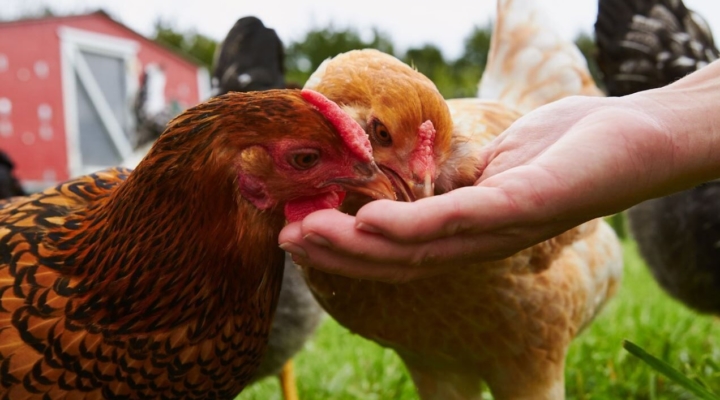What chickens can and should not eat

A poultry nutritionist answers this age-old backyard chicken question
SHOREVIEW, Minn. — Rhubarbs or roses? Which is a tasty treat for your chickens and which should you avoid? Whether you’re new to backyard chickens or you’ve had a flock for years, it’s important to know the do’s and don’ts of feeding your birds.
“As backyard chicken raisers, we love to treat our girls – especially as temperatures warm up and the flock spends more time outside,” says Patrick Biggs, Ph.D., a flock nutritionist for Purina Animal Nutrition. “But it’s not really the treats that make the flock come running, it’s the attention. Chickens will come running for complete feed, just as they would for treats.”
Backyard chickens have fewer than 350 taste buds compared to humans’ 10,000. Still, treats and foraging can be fun pastimes for the flock. If you’d like to offer treats and free-range time, here are a few tips to keep in mind.
90/10: The most important feeding rule to follow

“Chickens require 38 unique nutrients at the correct levels,” Biggs says. “Complete feeds are formulated to meet these demands. Choose one complete starter-grower feed for day 1 through week 18 and one complete layer feed for laying hens. To prevent nutrient dilution, provide complete feed for at least 90 percent of the bird’s diet.”
The remaining 10 percent can be filled with treats, including free-ranging.
But what does the 90/10 rule mean? Laying hens eat approximately 0.25 pounds of complete feed each day, which is about the same as one-half cup. When putting the 90/10 rule into practice, this means treats should not exceed 2 tablespoons.
“A few small treats are all they should have each day,” Biggs says.
For spring-born chicks moving to the coop, continue feeding a complete starter-grower feed until week 18. Wait until the first egg to introduce treats as growing birds require all 38 nutrients in their starter-grower feed to support strong growth.
What chickens can eat
If birds free-range or have treat access, start by feeding their complete feed in the morning before they go out exploring. Remember that scratch grains should be viewed as a treat and not be mixed with the complete feed.
“Chickens are natural foragers, so trying new foods is inevitable,” Biggs says. “Chickens tend to avoid foods that are bad or harmful for them, but some are healthier than others.”
When it comes to foraging, there is a lengthy list of plants that chickens love as treats. Dark leafy greens can result in darker, richer yolks. Lettuce, kale, turnip greens and chard are great greens options. Watermelon, strawberries, and blueberries make healthy snacks for chickens when fed in moderation.
A few flock favorites include:
- Vegetables: Lettuce, beets, broccoli, carrots, kale, swiss chard, squash, pumpkins and cucumbers
- Herbs: Lavendar, mint, oregano, parsley, cilantro, thyme and basil
-
Perennials: Daylilies, hostas, daisies, roses, coneflowers and ferns
“If birds are free-ranging, they will find their favorite plants and snack on them,” Biggs says. “Install a chicken fence or tunnel in the yard to keep them away from your favorite gardens and consider planting a chicken-friendly garden for them to explore. Place a Purina® Flock Block in the yard to encourage natural pecking.”
What chickens should not eat
“Avoid treats that may cause an off-flavor in eggs,” Biggs says. “Garlic and onions are the two most common culprits that may impact egg flavor.”
A few other foods should be avoided because they contain toxins that can make birds ill or even be fatal.
- Avocado pits and skins are toxic to chickens as they contain a toxin called persin. The flesh of the avocado is fine for chickens.
- Undercooked or dried beans can be harmful because they contain a compound known as hemagglutinin, which can inhibit digestion of everything the bird eats.
- Rhubarb contains anthraquinones, which can have a laxative effect. Rhubarb damaged by the severe cold can also contain a high concentration of oxalic acid, which can be fatal to chickens.
- Moldy, rotten foods and very salty foods can result in excessively wet feces and may be toxic.
“Feeding chickens a balanced and complete diet is simple if you follow the 90/10 rule and are mindful of the foods your birds have access to,” Biggs says. “Start with a complete feed as the baseline and then be careful not to over-treat your birds with goodies.”
To learn more about raising backyard chickens, visit www.purinamills.com/chicken-
Purina Animal Nutrition LLC (www.purinamills.com) is a national organization serving producers, animal owners and their families through more than 4,700 local cooperatives, independent dealers and other large retailers throughout the United States. Driven to unlock the greatest potential in every animal, the company is an industry-leading innovator offering a valued portfolio of complete feeds, supplements, premixes, ingredients and specialty technologies for the livestock and lifestyle animal markets. Purina Animal Nutrition LLC is headquartered in Shoreview, Minn. and a wholly owned subsidiary of Land O’Lakes, Inc.
